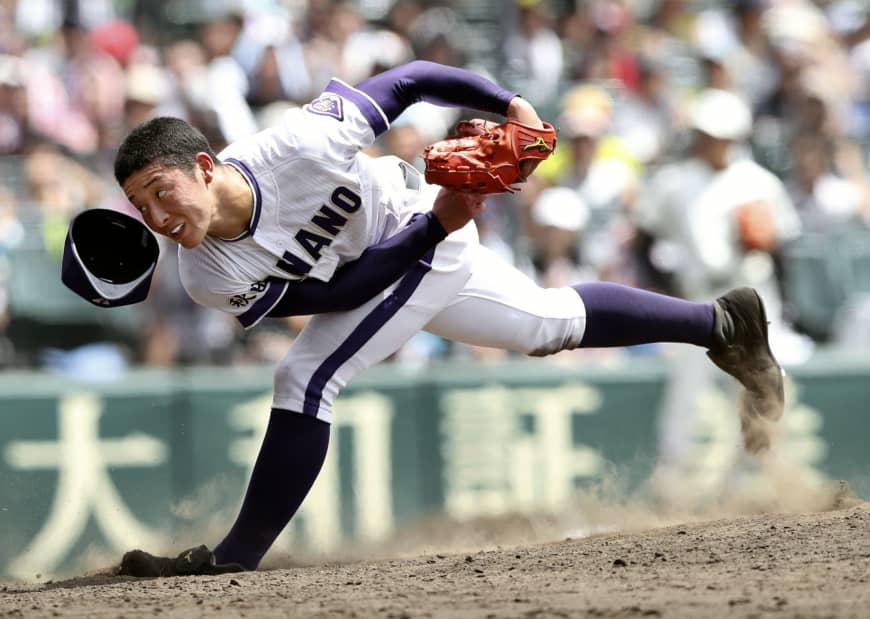Time has come for Japan to consider burden placed on young arms

The Japan Times; Feb 25, 2019 by Jason Coskrey
Kosei Yoshida threw more pitches in six games during last summer’s National High School Baseball Championship than NPB hurlers did in any one month last season.
Yoshida threw 881 pitches during Summer Koshien for Kanaashi Nogyo (Akita) High School, which made a Cinderella run to the final. Among NPB pitchers, the highest monthly total (per Deltagraphs) was 710 by the Hiroshima Carp’s Daichi Osera — who actually hit that number from Sept. 1 to Oct. 7 — in six starts. The high in MLB was 662 by the Washington Nationals’ Max Scherzer in May.
Yoshida didn’t just throw more pitches, he did it with much less time to recover. He threw five complete games and five innings of another from Aug. 8-21.
Yoshida was lauded for his grit and determination, but no one was admonished for putting him in that situation.
But perhaps that will change.
How best to protect the arms of young pitchers is a debate that has raged in North America for years. It finally reached Japan’s shores in earnest in December, when the Niigata Prefectural High School Baseball Federation announced it would implement pitch limits during its spring tournament, the first such rule in Japan. Under the proposal, a pitcher wouldn’t be allowed to start an inning after reaching 100 pitches.
The move was met with praise from some and condemnation by others. The Japan High School Baseball Federation on Feb. 20 said it would ask the Niigata body to reconsider its decision, but agreed something must be done.
“Regardless of what happens now, we have pushed the conversation forward,” Osamu Shimada, a executive member of the Niigata federation, told Kyodo News on the same day. “We’ve advanced the hands on the clock. Getting a pitch limit is not our final goal. We are going to continue to grapple with how best to protect these children.”
While we may not know exactly how many pitches it takes before the ligaments in an arm begin to fray, it’s not hard to identify an excessive amount for young and still-developing players.
Change often comes slowly in Japan, but it needs to happen. This time, the drumbeat behind reform seems stronger than usual. On Feb. 22, the Pony League announced an 85-pitch limit for its national tournament for players in their first year of junior high. Earlier in the month, Japan Sports Agency chief Daichi Suzuki also called for pitch limits.
Yokohama BayStars slugger Yoshitomo Tsutsugo has also called for limits for younger players. In January, Tsutsugo said while playing for Japan during the World Baseball Classic in 2017, he noticed the pitchers there were protected by pitch limits, while high schoolers in Japan weren’t.
What’s important now is that the conversation doesn’t get swept under the rug and forgotten.
Pitch limits might not be the perfect answer, but restraint is far better than putting still-developing players at the high school level and below under heavier burdens than professionals.
In college basketball, when Duke freshman forward Zion Williamson injured his knee during a game against North Carolina last week, much of the resulting frenzy was about the risk to his future career.
Well, the same applies for Japanese players in junior high and high school being asked to do things grown men balk at. How many would-be promising careers have already been derailed over time because of the toll of overuse during their developmental years?
From Daisuke Matsuzaka to Yuki Saito, the image of the schoolboy pitcher throwing to exhaustion has been romanticized for years in Japan. But times change, and the way Japan thinks about young pitchers must also evolve. The priority should be how best to protect the welfare of the kids playing the game, not about allowing adults to relive the glories of yesteryear.
Yoshida, like many small-school stars, was tasked with carrying the hopes of his school on his talented right arm during the 2018 Koshien tournament.
So he went to the mound every game, did his samurai pose and proceed to repeatedly hurl his arm forward with such force his hat would come flying off. He pitched and pitched and pitched until by the end there was nothing left and he was a shell of himself in the final.
We may not find out how much this cost Yoshida, who was drafted by the Hokkaido Nippon Ham Fighters, until much later. Hopefully he enjoys a healthy career.
Injuries are going to happen and there’s simply no way to prevent them all. But there are ways to lessen the risk, and hopefully that’s the ball the Niigata body got rolling in Japan in December.



